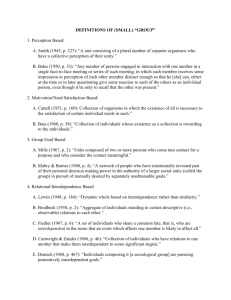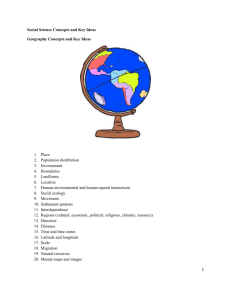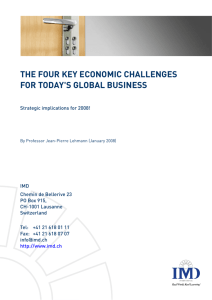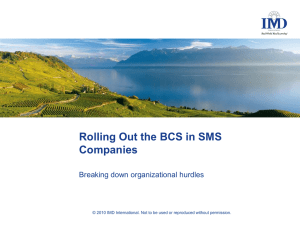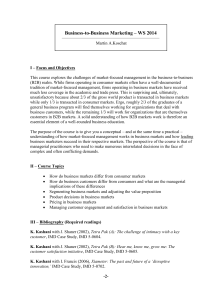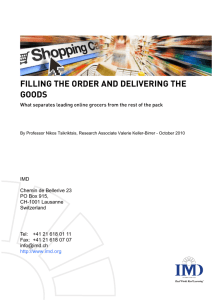Managing complexity in global organizations
advertisement
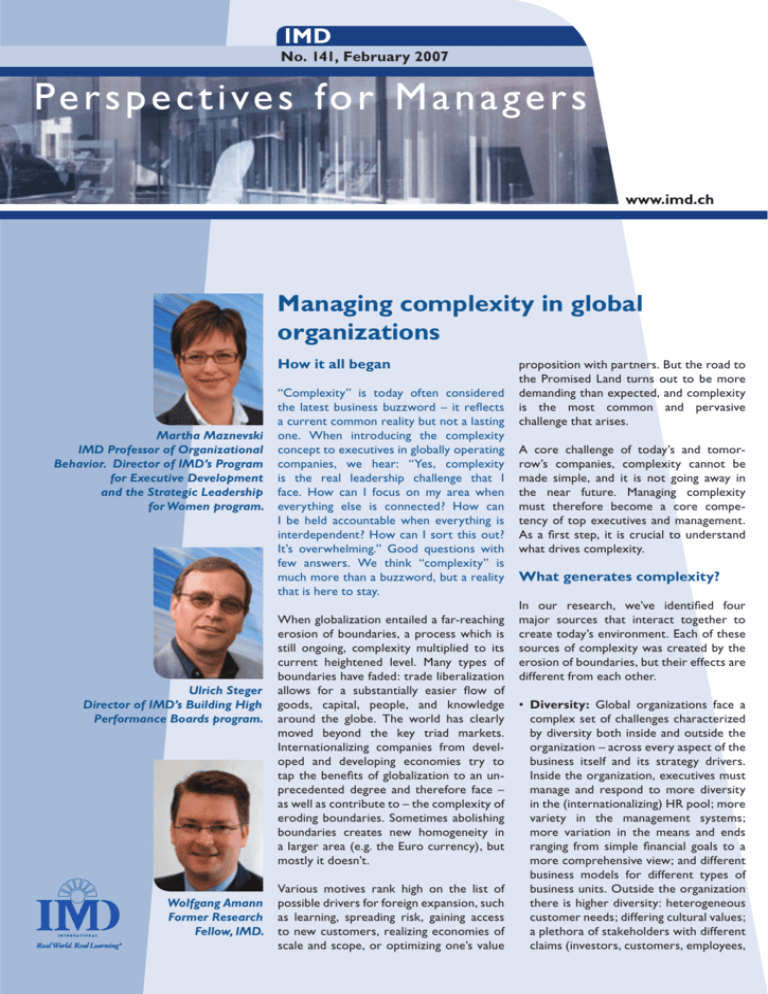
No. 141, February 2007 Managing complexity in global organizations How it all began Martha Maznevski IMD Professor of Organizational Behavior. Director of IMD’s Program for Executive Development and the Strategic Leadership for Women program. Ulrich Steger Director of IMD’s Building High Performance Boards program. Wolfgang Amann Former Research Fellow, IMD. “Complexity” is today often considered the latest business buzzword – it reflects a current common reality but not a lasting one. When introducing the complexity concept to executives in globally operating companies, we hear: “Yes, complexity is the real leadership challenge that I face. How can I focus on my area when everything else is connected? How can I be held accountable when everything is interdependent? How can I sort this out? It’s overwhelming.” Good questions with few answers. We think “complexity” is much more than a buzzword, but a reality that is here to stay. When globalization entailed a far-reaching erosion of boundaries, a process which is still ongoing, complexity multiplied to its current heightened level. Many types of boundaries have faded: trade liberalization allows for a substantially easier flow of goods, capital, people, and knowledge around the globe. The world has clearly moved beyond the key triad markets. Internationalizing companies from developed and developing economies try to tap the benefits of globalization to an unprecedented degree and therefore face – as well as contribute to – the complexity of eroding boundaries. Sometimes abolishing boundaries creates new homogeneity in a larger area (e.g. the Euro currency), but mostly it doesn’t. Various motives rank high on the list of possible drivers for foreign expansion, such as learning, spreading risk, gaining access to new customers, realizing economies of scale and scope, or optimizing one’s value proposition with partners. But the road to the Promised Land turns out to be more demanding than expected, and complexity is the most common and pervasive challenge that arises. A core challenge of today’s and tomorrow’s companies, complexity cannot be made simple, and it is not going away in the near future. Managing complexity must therefore become a core competency of top executives and management. As a first step, it is crucial to understand what drives complexity. What generates complexity? In our research, we’ve identified four major sources that interact together to create today’s environment. Each of these sources of complexity was created by the erosion of boundaries, but their effects are different from each other. • Diversity: Global organizations face a complex set of challenges characterized by diversity both inside and outside the organization – across every aspect of the business itself and its strategy drivers. Inside the organization, executives must manage and respond to more diversity in the (internationalizing) HR pool; more variety in the management systems; more variation in the means and ends ranging from simple financial goals to a more comprehensive view; and different business models for different types of business units. Outside the organization there is higher diversity: heterogeneous customer needs; differing cultural values; a plethora of stakeholders with different claims (investors, customers, employees, regulators etc.); various political, economic and legal environments; and finally, competitors’ differing strategies. Most firms today increasingly face each of these types of diversity. Managing the differences is not trivial, and reducing diversity often means being less responsive. • Interdependence: Companies must manage the effect of global interdependence to an unprecedented degree: everything is related to everything else, and the impact is felt more rapidly and pervasively. Value webs have replaced traditional value chains. Reputation, financial flows, value chain flows, top management and corporate governance issues have reached advanced levels of interdependence. The less clear-cut the boundaries of a company become, the more it is exposed to impacts on the value chain flow through mistakes, frictions, reverse trends, or even shocks. Interdependence creates opportunities for globalization, but taking advantage of these opportunities raises difficult challenges. • Ambiguity: The business world today is characterized by too much information with less and less clarity on how to interpret and apply insights. A diversity of accounting standards renders financial figures ambiguous. Studies, scenarios, survey results, and reports become less reliable due to an ever-increasing uncertainty. Many businesses find it more and more difficult to discover what their clear value drivers are. Are they image, price, related services, privileged relationships, speed, knowledge, or something else? The cause-effect relationships become blurred. • Flux: As if these three complexity drivers were not enough, managers have to face yet another one, flux or change. Even if you figure out temporary solutions regarding interdependence, diversity and ambiguity for your specific company, industry, and personal situation, the situation can change the next day. Today’s solutions may be outdated tomorrow. What are the repercussions? Everything is diverse, and nothing is stable, everything is in “fast flux”: interdependence is flowing in changing directions. The future is no longer the prolongation of the past – industry “breakpoints”, fundamentally altering the value proposition in industries, occur more rapidly. The variety of options could overwhelm traditional decision-making, as information often lacks clarity and is ambiguous. Multiple interpretations of the same facts are possible, depending on the perspective or cultural framework. Shared understanding cannot be assumed per se, whether inside or outside the organization. Thus, interdependence, diversity and ambiguity – all in flux – are the building blocks of managerial complexity and explain why global companies have often been perceived as the most complex organizations. Many people have tried to simplify complexity, and contemporary management literature is misleading when trumpeting THE success factor. Studies typically examine successful companies to see what managers “did”, then conclude that all managers should do the same thing. As unpredictability makes us uncomfortable, delusions are created about performance as voluntaristic matter of choice (companies can choose “to be great”); we like the certainty promised by these solutions. But in an interdependent world, much depends on contingencies, with no clear correction between input and output. Accountability of managers has therefore an arbitrary element: yes, managers are responsible, but results are influenced by factors beyond their control. Navigating through this complexity requires a different way of thinking, acting, and organizing than the typical “control” mentality. A long list of advantages lures companies into globalizing. Geographic expansion abroad offers the vast potential benefits of a much larger market arena, spread risks, scope-, scale- and location-based cost advantages, and exposure to a variety of new product and process ideas. The practical consequence of complexity is that a managerial dilemma often shapes the decision-making process when there are two or more conflicting legitimate goals to meet demands. Both cannot be simultaneously achieved with the given resources. Companies in the financial service industry set up competing distribution channels, but expect far-reaching cooperation across the company (shared services and product platforms) to reap economics of scale. In manufacturing, one ongoing dilemma is between global standardization and response to local market needs. Any required priority decision nevertheless results in ongoing tension. As dilemmas cannot be solved, they need to be managed – continuously. Ways to cope Global companies first reacted to this complex business environment by creating complex organizations. This was consistent with Ashby’s law of requisite variety, in that the complexity of an organization internally must match the complexity of its external environment. We saw multiple axes of management: along product lines, geography, customers, functions and projects. For example, ABB had a six-dimensional matrix structure (for a short time, at least, before they simplified the structure dramatically in their turnaround). The simple relation between headquarters as strategic decision-makers and subsidiaries as implementers is blurred by centers of excellence or competence, market responsibilities, joint ventures, etc. But structures and policies alone are not the solution. The more complex the structures and policies become, the more complex they are to manage. Eventually the organization implodes upon itself, spending more time managing the internal complexity than interacting with the environment, where real value is created. Companies complexity Ashby’s law complexity beginning to grapple with in effective ways interpret differently. They harness the already inherent within the Managing complexity in global organizations organization – people and relationships, and so on – to work for the company rather than against it. They add Thoreau’s advice to the recipe: simplify, simplify! But they choose carefully what they simplify, without making the organization or its processes too simple. In our book published in March 2007, Managing Complexity, we advise on focusing on the professional quality of decision-making. We encourage the simplification of organizational processes in specific ways, rather than predicting the outcome and simplifying one’s picture of the environment. Simplify a few key issues: Use complexity as an opportunity elsewhere We’ve identified four key issues around which companies must simplify: purpose and values; core processes and decentralization; early awareness systems; and leadership. Once these are clear and consistent, managers in different areas of the company can respond to complexity according to their own needs and realities. Purpose and values The purpose, our reason for being in this business, provides a “guiding star” on the horizon, a framework for prioritizing goals. Every business book talks about the importance of purpose and values, so perhaps this is nothing new. However, in simple and stable environments, even if the vision is a wishy-washy vague statement, it can provide enough guidance for people to manage well. But, in a complex environment, the guidance provided by a focused, even “discriminating” statement of purpose and values – what NOT to do – is absolutely critical. Every manager in the company should understand clearly and deeply what really drives the business, the fundamentals of the business’s profitability, and why the company is in business. This might be difficult for a diversified multi-national, but at least has to be achieved at the level of a Division/Strategic Business Unit. Once this is understood it leads to the values, the business “shoulds and oughts”, to determine priorities in dilemmas, help focus actions and provide consistent patterns of behavior over time. Companies best at dealing with complexity never have more than three or four core values, never to be compromised and therefore consistent with a compelling business logic. A longer “laundry list” of values is confusing at best and provides rationale for any action at worst. At the same time, it is helpful to have a few “behavioral values” beyond the core that guide the “how” of the execution; behavioral values can be compromised, but must be explained. A clearly defined and well accepted set of core values plus a guiding set of behavioral values therefore allows diversity at the periphery, local empowerment for adaptation, learning and experimentation, the existence of additional values per region, unit, profession – as long as they do not contradict the core values. Core processes and decentralized authority Core processes are those used by the entire company. These vary from business to business, but most managers know what is vital. In a consulting firm, core processes might be knowledge sharing and recruiting; in a heavy manufacturing firm they might be capital budgeting and logistics; in a pharmaceuticals firm they might be research and development and go-to-market processes. A firm’s core processes should always be standardized (not necessarily centralized) and based on comprehensive, accessible information platforms. As this imposes cost, one has to be very clear what is needed as core. Such processes might change over time, and more often than the business model or the core values. It is therefore important to erase old processes when introducing new ones. But only standardized processes generate the transparency key for accountability on levels further down the organization. With such transparency and accountability, therefore, decentralization is possible without the company breaking down into political silos and bickering fiefdoms. With decentralization consistent with core processes, local managers can engage complexity in the way most effective for them. Unpredictable situations – an early awareness system Chaos is a degree of complexity in which few of the rules and drivers are understood. Compare it to a weather forecasting system: never completely right, but rarely completely wrong. And early awareness doesn’t need sophisticated systems and much manpower. It is – more than anything else – a mindset, a sensitivity that allows “weak signals” that indicate emerging change and foresight to be understood. To deal with complexity, identify the variables that create predictable outcomes when they’re within a particular range, and unpredictable outcomes when they are not. As one executive recently told us, “We track hurricanes. As long as they stay outside of this range, we don’t pay much attention or put anything into action. But as soon as they hit inside this range, we start to put our contingency plans into place.” When facing complexity, managers need to identify which “hurricanes” they need to track, and which levels or ranges should trigger contingency plans. Leadership Leading a complex organization requires an entirely different mindset. Hierarchy works if every level is doing something distinct and specific. However, due to the interdependence in complexity, this is impossible in today’s organizations. By simplifying and clarifying vision and values, core processes and decentralization, and early awareness systems, hierarchy can be complemented by “heterarchy”, the interdependent, networked organization in which every part reflects a different perspective of the whole and which is needed in today’s global business world. The boss no longer needs to “tell” the team members what exactly to do, but rather depend on their initiative, creativity and competence for success. Leadership in a networked organization means not only providing different leadership roles and styles depending on the situation (but always consistent with the purpose, values, and core processes), but also leading different parts of a networked organization to work together to create value. The leader of a complex organization must create and communicate understanding of the different roles managers, teams, business units, and bosses play in the inter-dependent structure, otherwise confusion is intensified. Leadership cannot be repetitive, but should be predictable. Permanent communication is therefore the leadership survival tool in complex organizations, but much more in terms of “storytelling”, interpreting context and meaning, and investing in relationships than in transferring dry facts or ultimatums. Mastering global complexity We have not yet come across a company having mastered global complexity – perhaps there are none, perhaps there never will be any! However, various sections of “Managing Complexity” point to several global companies highlighting various aspects of managing complexity, or the effects of not managing it well. The decade-long difficulties of General Motors (GM) – and to a lesser degree Ford – clearly have their roots in the long traditional control mode, leading to GM’s vast bureaucracy and a typical outcome: mediocre products due to risk aversion, mistrust of management (reflected in the high degree of unionization), high transaction costs and slow response. An opposite example is Toyota, with a very clear value set (which is now challenged as it becomes a truly global company), a simpler model of core business processes and standardized processes throughout the world. (The famous notion that every engineer at Toyota can work in every Toyota factory of the world without having adaptation problems, is probably slightly exaggerated, but only slightly…). A similar set of elements are found in other global companies: family businesses, a luxury goods business (due to the identification with the product) or Dupont, known for strong values on safety. R&D driven industries, such as the pharmaceutical industry, are known for focused business models (if they have not overcompensated this by seize-through mergers). Energy companies, especially Exxon Mobile, are driven by standardized global processes, whereas fast-moving custom goods and the food industry are known for strong regional decentralization, but bound together they have shared processes across business lines. Although no company may ever master complexity completely, it is possible, using these principles, to at least navigate through complexity and even to take advantage of it. IMD P. O. Box 915, CH 1001 Lausanne, Switzerland Tel.: +41 21 618 0111 Fax: +41 21 618 0707 info@imd.ch http://www.imd.ch © IMD, February 2007. No part of this publication may be reproduced without written authorization.
